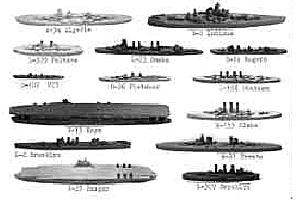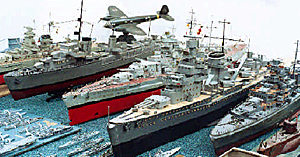 Dockyard Model
Dockyard Model
The dockyard model was a chef d'oeuvre for selling one’s naval wares all throughout the sailing ship and steam-powered epochs, only declining with the advent of computer simulation graphics that could present the 3-d preview more cheaply and more thoroughly than the miniature. Only the affluent can afford to purchase the handful of these models on the market today.
There are basically three types of ship models of interest to the aficionado – I am excluding the bland tank-testing model used by naval architects, but some devotees also collect these.
Static Precision Scale Model
The first, which is my personal favorite, is the static precision scale model meant to adorn a desk or mantle. These usually range in size from a few inches to three feet. The model over a yard in length becomes a bit cumbersome for display in the home or office. Of course there is a subcategory of the foregoing which is the “museum specimen” model. As much as I admire museum display models, it is both impracticable from both cost and size aspects for most individuals to collect these. The standard museum scale is 1/48 or 1/8th of an inch to the foot. For larger vessels over 500 feet, the museum will often resort to 1/96 scale, where 1/16th of an inch represents a foot.
Museum galleries generally utilize models in the range of six feet long and more. I have seen some of the models of this scale exhibited in restaurants. For example, Clyde’s, a favorite dining spot in the Washington, DC Metropolitan area, has a “transportation” theme. They have railroad, aerial and motor vehicle models on display as well. However, whenever I dine there, I try to seat myself near one of their excellent models of the Great Ocean Liners, which are as a rule about ten feet long. My guess is that many of these were specially commissioned works done by the same artisans that worked on the museum case models.
Pond Models
Next in line are the “pond models”, which are larger than display models and are intended to be sailed in tanks, ponds or lakes utilizing either sail or motor power. Many are rigged for radio control – even the sailing types. While many of these models are so precise as to look at home in the maritime gallery of a museum, I favor those more quiescent models that embellish the workplace or den.
However, pond model enthusiasts are a stalwart and active lot. Usually working in what might be considered museum scales and higher, their creations are a bit bulky for display in the home – unless one lives in a vast palatial manor.
Bottle Ship
A third type, really another subcategory of the display model, is the bottle ship. The art of constructing the model centers around making upperworks are collapsible and thereby capable of being slipped through the narrow neck of the bottle, and adjusted back to their standing position once inside the wider body of the bottle. This feature should not detract from the accuracy of the model, however; the finest specimens are as carefully fashioned as any other of their scale. The glass in the bottle should not distort the view so that details might be fudged.
I have seen internet websites that offer “bottle models” for $50-$100 or so. The models seem to be rather roughly fashioned and the model maker obviously depends on the image distortion to mask his models’ superficiality. As an example of what a quality bottle model is getting, I refer once again to e-bay, where a very fine specimen representing an 18th century frigate in about 1:250 scale (large for the bottle models which are usually 1:400 scale) sold for $3,500 in mid-2002. Some believe that sailors off watch originally constructed these little ships. The seamen would have little room to store models and the bottle was both intriguing for the challenge and useful since it protected the model while it was stashed away in a sea chest.
Sailing men-of-war, often anachronistically referred to as “battleships”, are another favorite subject. Most model collections show the customary Constitution, Raleigh, Wasp, Argus, or Constellation, but rarely one of the many other interesting vessels. One of the difficulties in navy ship models is that many sailing men-of-war had long lives and were changed somewhat on almost every commissioning; so for a single ship there may be a number of deck plans and spar dimensions representing a ship at some period in her life.
Throughout this article, I have referred to the matter of scale – that is, the relationship of the model’s size to that of it’s subject. The most consistent way to describe scale is the ratio. So 1:48 scale means that the model is 1/48th the size of the actual vessel. This ratio is just as often expressed in terms of how many inches on the model represents how many feet on the full-sized version. Staying with our 1:48 scale, this translates to one inch on the model being the equivalent of four feet on the ship.
I could continue with a review of the ultimate “minis”: the 100-foot-to-the-inch 1:1200 and 1:1250 scale models and their poor cousins, the 1:1500, 1:2000 and 1:3000 naval wargame markers. However the story of this sub-genre is a story in itself and would extend this already lengthy review to ponderous proportions. Suffice it to say that the collectors of this scale warships and merchantmen are among the most active and numerous model ship hobbyists extant. The degree of detail and accuracy lavished on these diminutive fleets is truly astounding.
 Anyone venturing into my 10 by 10 foot home office, totally lined with bookshelves, will either be impressed
or distressed by my array of models representing cruise ships and liners, warships, tugs,
workboats, hydrographic and environmental survey craft, freighters, submarines, large motor-yachts, and
submarines, alongside the few odd aircraft, cannon and miniature knights.
Anyone venturing into my 10 by 10 foot home office, totally lined with bookshelves, will either be impressed
or distressed by my array of models representing cruise ships and liners, warships, tugs,
workboats, hydrographic and environmental survey craft, freighters, submarines, large motor-yachts, and
submarines, alongside the few odd aircraft, cannon and miniature knights.
As I hope I have established, the collection is not mere whimsy, but reflects my long-standing fascination with the sea and seafaring, which resonates in my expository compositions on the topic. I will make no further excuses. One might be privileged either to stay and admire the collection or go talk with my wife, who might lend a sympathetic ear to their disapproval of my potpourri of nautical playthings. Unlike the youthful budding author Zhitkov, encountered at the beginning of the article, I promise NOT to – nor WILL I— mutilate my model ships while I “hunt the little fellows”.
The Lure and Lore of Model Ships
Back to Cry Havoc #40 Table of Contents
Back to Cry Havoc List of Issues
Back to MagWeb Master Magazine List
© Copyright 2002 by David W. Tschanz.
This article appears in MagWeb (Magazine Web) on the Internet World Wide Web. Other military history articles and gaming articles are available at http://www.magweb.com